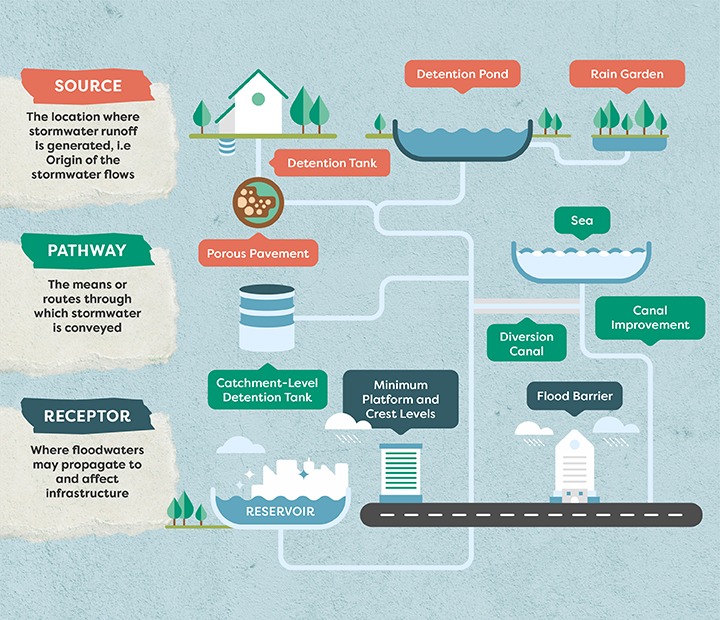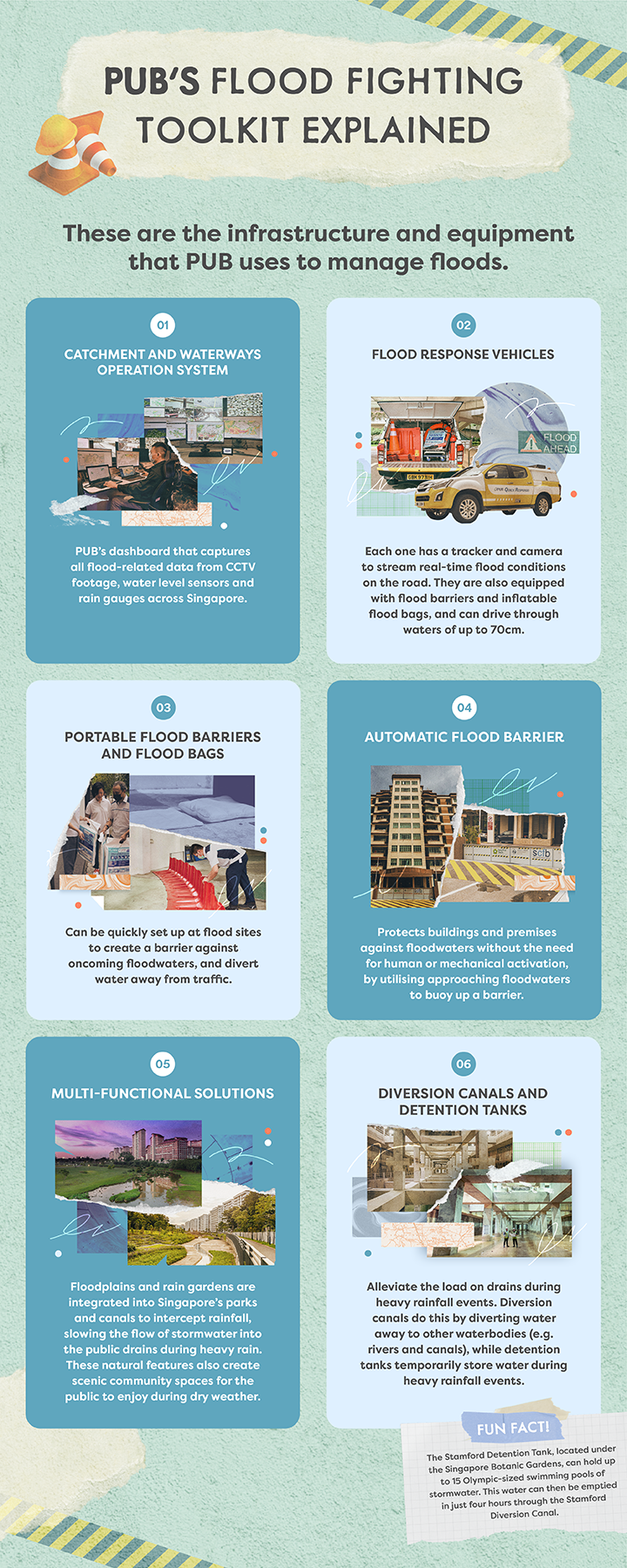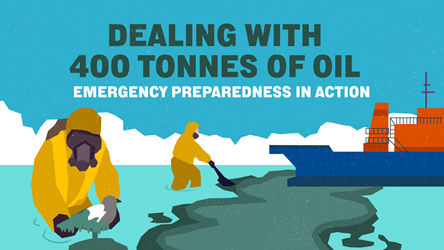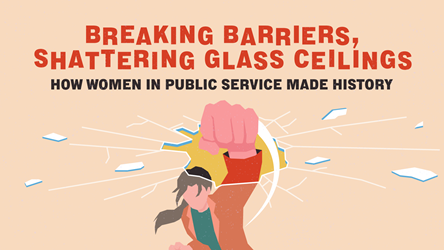Singapore’s Flood Fighters – And Why We Need Them

When heavy rain falls in Singapore, most of us worry about getting wet or getting home without an umbrella.
At PUB’s Joint Operations Centre, the officers on duty go on high alert. Eyes fixed on the screens in front of them, they scan weather radars and CCTV footage of drains and canals, all while keeping a close watch on data from water level sensors and rain gauges.
Then, a notification pings on their computer screens: an area is at risk of experiencing a flash flood.
A call is made, and the Quick Response Team on standby in the area jumps into action, rushing to the scene within 20 minutes. Should a flash flood occur, the officers, armed with traffic cones, light batons, and flood barriers, swiftly divert traffic away from the floodwaters.
These heroes are Singapore’s very own flood fighters – the officers of PUB’s Catchment and Waterways Department.
Singapore’s History With Flood Resilience
So why the need for flood fighters in the first place?
Singapore is no stranger to floods. During the 1950s-80s, the island experienced frequent and widespread flooding. Some of these floods had water levels that reached 1m in height (as high as your waistline!), and some floods even lasted days.
Since then, Singapore has made significant strides in flood management.
According to PUB, flood-prone areas in Singapore have reduced from 3,200 hectares (ha) in the 1970s to less than 30 ha in 2023. This is due to decades of continued efforts and significant investments to expand Singapore’s drainage network and infrastructure to mitigate flood risk.
But we shouldn’t stop there. Mr Darren Lew, Senior Principal Engineer (Flood and Incident Response) at PUB, explains: “Enhancing our flood resilience is more important than ever today. Climate change intensifies extreme weather events that could temporarily overwhelm our drainage capacity and increase flood risk.”
He adds: “While flash floods today typically subside within an hour, our priority is still to ensure public safety by responding quickly to flooding incidents, as well as keeping people out of harm’s way.”

Preventing Floods Upstream and Downstream
Ever wondered why you need to walk up a flight of stairs before heading down the escalator into an underground MRT station? That’s because the entrance is designed to be higher than the adjacent ground level for flood protection.
This is just one aspect of PUB’s holistic approach to stormwater management. Known as the “Source-Pathway-Receptor” strategy, it introduces flexibility and adaptability to Singapore's entire drainage network. This helps to achieve a sustainable stormwater management system and enhance our flood resilience.
While PUB continues to improve and upgrade our drains and canals, it is not possible to keep widening existing drains in land-scarce Singapore.
Other measures that complement these upgrades can be implemented – such as controlling the rate of stormwater runoff at the Source. For example, sizeable developments (0.2 ha or more) are required to implement onsite measures such as detention tanks or ponds to slow stormwater flow into drains and canals during a heavy rain event.
Is It Possible To Predict Floods?
To enhance rainfall forecasting, PUB currently uses modeling tools and digital elevation maps to simulate different rainfall intensities on Singapore’s drainage systems.
This allows them to identify flood-vulnerable areas under climate change scenarios and develop drainage solutions that match the unique characteristics of the area.
There are also continuous drainage upgrading and improvement works to strengthen flood protection in low-lying areas and flood hotspots.
Ms Joanne Siew, Senior Principal Engineer (Drainage Planning) at PUB, explains that the agency prioritises improving drainage infrastructure in areas where floods have already occurred, and at locations with upcoming infrastructure developments that may require increased drainage capacity.

Because climate change is unpredictable, relying on only one aspect of flood management is not enough to protect Singapore against floods.
“We can never fully predict nature or cater to every extreme rainfall event,” Darren Lew shares. “However, we can ensure effective flood management through a holistic combination of a robust drainage system and effective flood monitoring and response measures.”
Looking Ahead: Climate Change and the Future of Flood Resilience
Climate change will not only increase the risk of flash floods caused by extreme rainfall events. Rising seas will increase the risk of coastal flooding in Singapore. Today, about a third of our land is less than 5m above the mean sea level, while sea levels around Singapore are expected to rise by 1m by 2100.
In April 2020, PUB was appointed the National Coastal Protection Agency to lead and coordinate whole-of-nation efforts to protect Singapore’s coastlines.
So far, PUB has started developing a Coastal-Inland Flood Model to better assess the combined threat of rising sea levels and more intense rainfall on Singapore’s coastlines. They have also conducted site-specific studies at various segments of the coastline.
Ms Sarah Hiong, Senior Assistant Director (Masterplanning and Research) of PUB’s Coastal Protection Department, adds: “We see this as an opportunity to develop coastal infrastructure that can transform Singapore’s coastal areas into vibrant, attractive and liveable spaces, while also protecting our country against the existential threat of rising sea levels.”
Building Singapore’s flood resilience in the face of climate change for both inland flooding and coastal flooding is a shared responsibility. Everyone has a role to play in ensuring proper maintenance of our drains, preparing our communities for flash floods and co-creating places that are resilient against both heavy rain and rising seas.

To get more stories like this, subscribe to the Challenge Telegram channel.
- POSTED ON
Mar 23, 2023
- TEXT BY
Hidayah Md Sham
- PHOTOS BY
PUB
- ILLUSTRATION BY
Liew Xinyi









